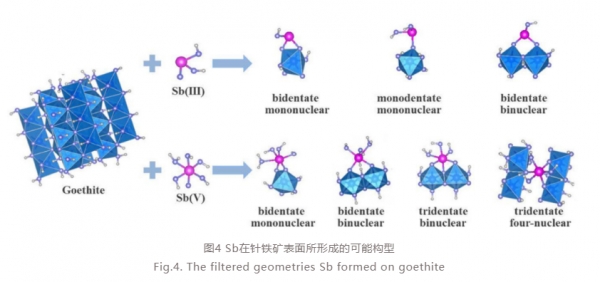导读 | Introduction
锑(Sb)与砷(As)同为元素周期表第五主族元素。与As一样,Sb可干扰生命体新陈代谢,具有一定的生物毒性。Sb在环境中常以III、V两种价态存在,且Sb(III)毒性强于Sb(V)。Sb因具有阻燃性强、硬度大等特点而被广泛应用于二极管、电池、阻燃剂等工业生产中。我国锑产量位居世界之首,锑矿的开采和冶炼致使冶矿区及周边土壤遭受严重锑污染,对矿区居民的健康造成一定的威胁。土壤中的铁氧化物因具有表面功能基团多、丰度大等特点,显著影响Sb在土壤中的迁移转化过程。为了深入了解铁氧化物对Sb迁移转化行为的影响机制,本论文将电荷分布多位点络合模型(CD-MUSIC)、扩展X射线吸收精细结构谱(EXAFS)与密度泛函理论(DFT)相结合探究了Sb在针铁矿不同晶面上的结合机制。
Antimony is a non-essential element for plants and animals and toxic to organisms at elevated concentrations (Filella et al., 2007). Due to its high hardness, flame resistance and low price, Sb is widely used in industrial production including alloy, spinning, glassware, bullets, pigments and so on (Filella et al., 2002; Leuz et al., 2006; Sparks, 2003). The exploitation and smelting of Sb and the application of Sb-containing products result in heavy soil pollution near the sites, thus leading to increasing concerns about Sb as an emerging pollutant (Gebel, 1997). As an important ingredient and strong adsorbent of soil, iron oxide is deemed to be the major host phase of Sb for its huge specific surface area and numerous surface hydroxyl groups. Herein, in order to elucidate the adsorption mechanism of Sb on Fe oxides at the molecular level, a systematic experimental and theoretical study were conducted. Thermodynamic and kinetic sorption experiments, combined with charge distribution multi-site complexation (CD-MUSIC) model, EXAFS spectroscopy, and DFT calculations, were carried out to provide a consistent and complementary characterization of Sb adsorption processes on goethite spanning from molecular to macroscopic scales, which would be helpful in clarifying the fate and geochemical cycling of Sb in soils.
https://mmbiz.qpic.cn/mmbiz_jpg/NSLiaTy8HiaJCc24occ1TWQSiafzkkaJQ7vOBQicicydfT7ODhsSkEU1mhfXVgaR2tH0nOtj0wLArvVIS8hscS1o0og/640?wx_fmt=jpeg&from=appmsg&tp=wxpic&wxfrom=15&wx_lazy=1");">
一、Sb在针铁矿表面的吸附边以及CD-MUSIC模型拟合结果
pH sorption edge and the fitting by CD-MUSIC model
Sb(III)和Sb(V)在针铁矿表面的吸附量随pH变化的趋势有明显区别(图1)。pH对Sb(III)吸附量影响较小,最大吸附量在6 ~ 7之间,约为13.5 mg·g−1,然而,pH对Sb(V)吸附量影响却很大,Sb(V)吸附量随pH增加而迅速降低,当pH为3时,Sb(V)吸附量为16.9 mg·g−1,而当pH高至11时,Sb(V)吸附量仅为10.7 mg·g−1。CD-MUSIC模型拟合结果表明,双齿双核和单齿单核构型是Sb(III)和Sb(V)在针铁矿表面最可能形成的构型。
Sb(III) and Sb(V) sorption on oethite over the pH range of 3–11 was examined (Fig. 1), which displays significantly different patterns. Sb(III) sorption capacity was weakly dependent on pH and the sorption maximum (13.5 mg·g−1 ) was achieved in the pH range of 6–7. In contrast, Sb(V) sorption capacity decreased violently with increasing pH. Sb(V) sorption capacity was 16.9 mg·g−1 at pH 3 while it was 10.7 mg·g−1 at pH 11. According to the fitting results by CD-MUSIC model, bidendate binuclear and monodentate mononuclear complexes were the most prominent surface species for both Sb(III) and Sb(V).

二、Sb在针铁矿表面的搅拌流动动力学
Stirred-flow sorption kinetics of Sb on goethite
通过搅拌流动动力学实验获取Sb在针铁矿表面的动力学参数。图2描述了pH为5.5和7.0时Sb吸附动力学过程。稀释曲线和出流液浓度的差值反映了Sb在针铁矿表面的吸附速率。稀释曲线和出流液曲线围成的面积反映了Sb在针铁矿表面的累积吸附量。可推知,Sb(III)的吸附速率和吸附量在pH 5.5和7.0时均高于Sb(V)。采用准一级动力学和二级动力学对动力学数据进行拟合,二者的拟合结果均表明针铁矿对Sb(III)的吸附量高于Sb(V)。
Stirred-flow kinetic experiments were carried out to obtain the kinetic data for Sb sorption on goethite. Sb concentration in the effluent over time at pH 5.5 and 7.0 is shown in Fig. 2a. The difference between Sb concentration in dilution curve and the effluent reflects Sb sorption rate on goethite over time. The region enclosed by Sb concentration of the dilution curve and the effluent represents the accumulated Sb sorption quantity on goethite. Fig. 2b shows that Sb(III) sorption rate and sorption quantity were higher than that of Sb(V) at both pH 5.5 and 7.0. The pseudo-first-order kinetic model and the pseudo-second-order kinetic model were used to fit the kinetic data. Sorption capacity at equilibrium (Qe) predicted by pseudo-first-order kinetics and pseudo-second-order kinetics both reflected the higher Sb(III) sorption capacity on goethite than Sb(V).
三、EXAFS分析 | EXAFS analysis
针铁矿吸附Sb样品的EXAFS光谱如图3所示。每个样品中都拟合到了Sb-Fe壳层。在Sb(V)-pH 5.5 样品中仅拟合到了距离为 3.12 Å 的Sb-Fe壳层,而在Sb(III)-pH 5.5、Sb(III)-pH 7.0和Sb(V)-pH 7.0样品中拟合到了距离为3.10–3.14 Å 和3.50–3.58 Å 两个Sb-Fe壳层。也就是说,在Sb(III)-pH 5.5、Sb(III)-pH 7.0、Sb(V)-pH 7.0体系中,Sb在针铁矿表面形成了共边和共角配合物,而在Sb(V)-pH 5.5体系中,Sb在针铁矿表面只形成了共边配合物。
Fig. 3 shows the k3 - weighted Sb K-edge EXAFS spectra and the corresponding Fourier transformed spectra of the sorption samples. Sb-Fe shells were obtained in every Sb sorption samples. Only one Sb-Fe shell with the distance of 3.12 Å was obtained in Sb(V)-pH 5.5 system while two Sb-Fe shells with the distances of 3.10–3.14 Å and 3.50–3.58 Å were obtained for Sb(III)-pH 5.5, Sb(III)-pH 7.0, and Sb(V)-pH 7.0 systems. That is to say, Sb formed both edge-sharing and corner-sharing complexes on goethite for Sb(III)-pH 5.5, Sb(III)-pH 7.0, and Sb(V)-pH 7.0 systems while forming edge-sharing complex on goethite for Sb(V)-pH 5.5 system.
四、密度泛函理论计算 | DFT calculations
为了进一步揭示Sb在氧化铁表面的吸附机制,我们采用DFT计算了Sb吸附最优构型。DFT计算所得的Sb在针铁矿各晶面的络合结构如图4所示,一共获得8种Sb(III)表面络合构型和9种Sb(V)表面络合构型。
To figure out the specific configuration of the edge-sharing and corner-sharing complexes Sb formed on goethite preliminarily revealed by EXAFS spectroscopy, DFT calculations were used to obtain the optimized geometry. The DFT structures and energetics of inner-sphere adsorbed Sb species on (001), (010), (021), (100), and (110) crystal planes of goethite are calculated. 8 Sb(III) surface complexes and 9 Sb(V) surface complexes were considered to be the possible geometries Sb formed on goethite.
 EXAFS和DFT计算结果表明:Sb(III)可在针铁矿(001)晶面形成双齿单核结构,(001)、(110)晶面上形成单齿单核结构,在(001)、(010)、(021)、(110)晶面形成双齿双核结构;Sb(V)可在针铁矿(001)晶面上形成双齿双核结构,在(010)、(021)晶面形成三齿双核结构,在(001)、(010)、(100)晶面形成双齿双核结构,在(021)晶面形成三齿四核络合物。相比Sb(V),Sb(III)与针铁矿的结合构型热力学稳定性更高,表明土壤中Sb(V)的迁移能力强于Sb(III)。
EXAFS和DFT计算结果表明:Sb(III)可在针铁矿(001)晶面形成双齿单核结构,(001)、(110)晶面上形成单齿单核结构,在(001)、(010)、(021)、(110)晶面形成双齿双核结构;Sb(V)可在针铁矿(001)晶面上形成双齿双核结构,在(010)、(021)晶面形成三齿双核结构,在(001)、(010)、(100)晶面形成双齿双核结构,在(021)晶面形成三齿四核络合物。相比Sb(V),Sb(III)与针铁矿的结合构型热力学稳定性更高,表明土壤中Sb(V)的迁移能力强于Sb(III)。
本研究通过对Sb在针铁矿各晶面的吸附机制的探究,加深了对土壤中Sb的吸附特性机理的理解,提供了建立表面络合模型的参数基础以预测锑在宏观尺度上的迁移和固定,并有助于制定利用铁基材料修复受锑污染土壤的策略。
Based on the results obtained from EXAFS spectroscopy and DFT calculations, we propose that the main retention mechanism for Sb(III) on goethite was bidentate mononuclear complex on (001) crystal plane, monodentate mononuclear complex on (001) and (110) crystal planes and bidentate binuclear complex on (001), (010), (021), and (110) crystal planes. The main mechanism for Sb(V) on goethite was bidentate binuclear complex on (001) crystal plane, tridentate binuclear complexes on (010) and (021) crystal planes, bidentate binuclear complexes on (001), (010), and (100) crystal planes, and the tridentate four-nuclear complex on (021) crystal plane. The geometry for Sb(III) forming with goethite was more thermodynamically stable than Sb(V), indicating the higher mobilization of Sb(V) than Sb(III) in soils. Based on the extensive theoretical exploration of the chemical space of Sb species adsorption processes on different goethite surfaces, this study consolidates the mechanistic understanding of the adsorption characteristics of Sb in soils. It also provides a parameter basis for establishing the surface complexation model to predict the transport and immobilization of Sb in macroscopic scales, and helps develop remediation strategies utilizing iron-based materials for Sb contaminated soils.


